
Epiphryne verriculata, the cabbage tree moth, is a moth in the family Geometridae. It is found only in New Zealand, and only feeds on the native cabbage tree ; its wings are patterned to camouflage it against dead cabbage tree leaves.
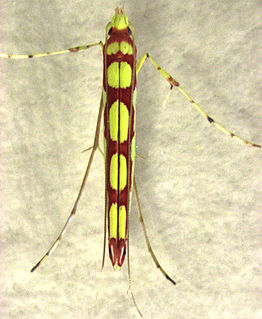
Macarostola miniella is a species of moth in the family Gracillariidae. It is endemic to New Zealand. This species is only found in the North Island and the adult moths have two different colour variations.

Glyphipterix tungella is a species of sedge moth in the genus Glyphipterix. It is endemic to New Zealand.
Prophantis octoguttalis is a species of moth of the family Crambidae. The species was described by Baron Cajetan von Felder, Rudolf Felder and Alois Friedrich Rogenhofer in 1875. It is found on the Maluku Islands in Indonesia.

Epiphryne undosata is a moth of the family Geometridae. It is endemic to New Zealand.
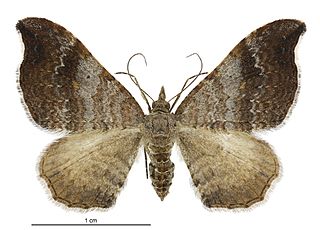
Homodotis megaspilata, also known as the small hooked-tip looper moth, is a moth of the family Geometridae. It is endemic to New Zealand and can be found throughout the country. It is regarded as being common species. The preferred habitat of this species is native forest, scrub, coastal areas and domestic gardens. Larvae feed on the dead leaves of Geniostoma ligustrifolium and likely other native plants. Once mature the larvae will pupate on the ground forming a silken cocoon protected by hiding inside two leaves of its host plant. Adults are nocturnal and are on the wing from October to April. They are attracted to light. In appearance the adults of this species are extremely variable but can be distinguished from similar species as all variations have forewings with blunt hook shaped tips.
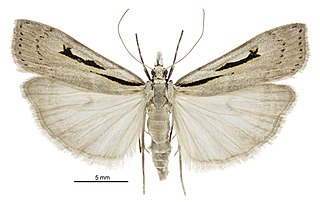
Scoparia rotuella is a species of moth in the family Crambidae. It was first described by Cajetan Felder, Rudolf Felder and Alois Friedrich Rogenhofer in 1875. It is endemic to New Zealand and, although considered localised, is found throughout the country. As at 2022 the life history of this species is largely unknown, but it has been hypothesised that this species may have two broods a year. Adults are on the wing all year round and are attracted to light.

Scoparia ustimacula, also known as the black-marked brown Scoparia moth, is a species of moth in the family Crambidae. It was described by Cajetan Felder, Rudolf Felder and Alois Friedrich Rogenhofer in 1875. It is endemic to New Zealand and can be found in the North, South and Stewart Islands. This species inhabits dense native forest at altitudes from sea level to approximately 1000 m. Although little is known of the life history of this species, larvae have been observed feeding on Hydrocotyle species. Adults are on the wing year round but are more commonly observed from September to March. Adults are nocturnal, are attracted to light and have been collected by beating scrub.

Apoctena taipana is a species of moth of the family Tortricidae. It is endemic to New Zealand and has been observed in both the North and South Islands. The larvae created a silken tube in which they hide and also use to travel from leaf to leaf. They tunnel into the leaves of their host. Larvae can be found from June to August. Adult moths can be seen on the wing from October to January.

Gadira acerella is a moth in the family Crambidae. It was first described by Francis Walker. It is endemic to New Zealand and is found throughout the country. The species inhabits native forest from sea level up to subalpine altitudes. Larvae are assumed to feed on lichen or moss. Adults are on the wing from October until March, are active at night and are attracted to light. This species is distinctively patterned and coloured and is said to resemble a bird dropping at rest. The colouring also assists to camouflage the moth when it rests against lichen.

Orocrambus tuhualis is a moth in the family Crambidae. It was described by Cajetan Felder, Rudolf Felder and Alois Friedrich Rogenhofer in 1875. It is endemic to New Zealand, where it has been recorded in the South Island and Wellington in the North Island. This species prefers habitat that consists of swampy areas.
Glaucocharis interruptus is a moth in the family Crambidae. It was first described by Cajetan von Felder, Rudolf Felder and Alois Friedrich Rogenhofer in 1875 and named Crambus interruptus. It is endemic to New Zealand.
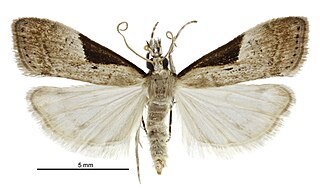
Eudonia pongalis is a moth in the family Crambidae. It was described by Cajetan Felder, Rudolf Felder and Alois Friedrich Rogenhofer in 1875. It is endemic to New Zealand.
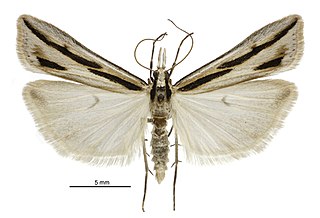
Eudonia trivirgatus is a moth in the family Crambidae. It was first described by Cajetan Felder, Rudolf Felder and Alois Friedrich Rogenhofer in 1875 as Crambus trivirgatus. It is endemic to New Zealand.
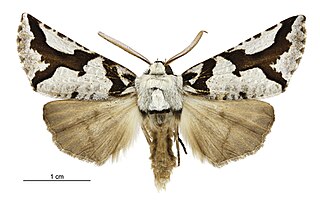
Declana egregia, commonly called the South Island lichen moth or zebra lichen moth, is a moth in the family Geometridae, endemic to New Zealand. This species was first described by entomologists Baron Cajetan von Felder and Alois Friedrich Rogenhofer in 1875 under the name Chlenias egregia.

Asaphodes obarata is a moth in the family Geometridae. It is endemic to New Zealand and has been collected in both the North and South Islands. It seems to inhabit the margins of native forest and also frequents plains with an affinity for gorse hedges. The host plants of the larvae of this species are unknown. The adults are on the wing in December and January. It is classified as critically endangered by the Department of Conservation. There has been a contraction of range of A. obarata with it now being regarded as locally extinct in both Dunedin and Invercargill.
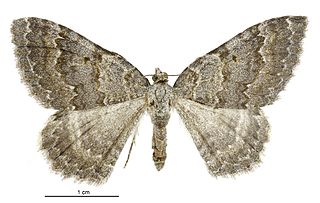
Gingidiobora subobscurata is a species of moth in the family Crambidae. It is endemic to New Zealand. This species has been classified as "At Risk, Declining" by the Department of Conservation.
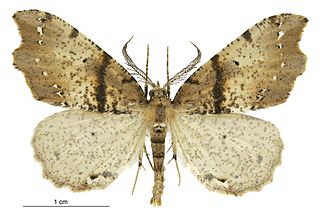
Chalastra pellurgata, also known as the brown fern moth or the pale fern looper, is a moth of the family Geometridae. This species was first described by Francis Walker in 1862. It is endemic to New Zealand and can be found throughout the country. It inhabits native forest. This species is extremely variable both in its larval and adult life stage. Larvae of this species are active during spring and summer. They feed on the fronds of fern species. C. pellurgata pupates by forming a thin cocoon on the soil amongst leaf litter and moss. Adults are on the wing throughout the year but are most common from September to March. During the day adult moths can be observed resting on dead fern fronds. They become active from dusk and are attracted to light.
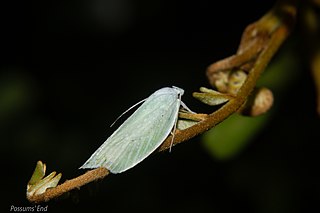
Nymphostola is a monotypic moth genus in the family Oecophoridae or the family Depressariidae. The genus was erected by Edward Meyrick in 1883. Its only species, Nymphostola galactina, the tarata flat moth, was described by Cajetan Felder, Rudolf Felder and Alois Friedrich Rogenhofer in 1875. It is endemic to New Zealand.
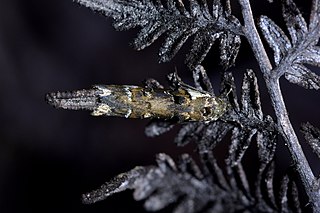
Trachypepla conspicuella is a species of moth in the family Oecophoridae. It is endemic to New Zealand and is found in both the North and South Islands. It is similar in appearance to its close relative T. euryleucota but tends to be paler. Its colouration imitates bird droppings. Larvae feed on leaf litter. Adults of this species are on the wing from November to February and have been observed resting on fences and walls.



















